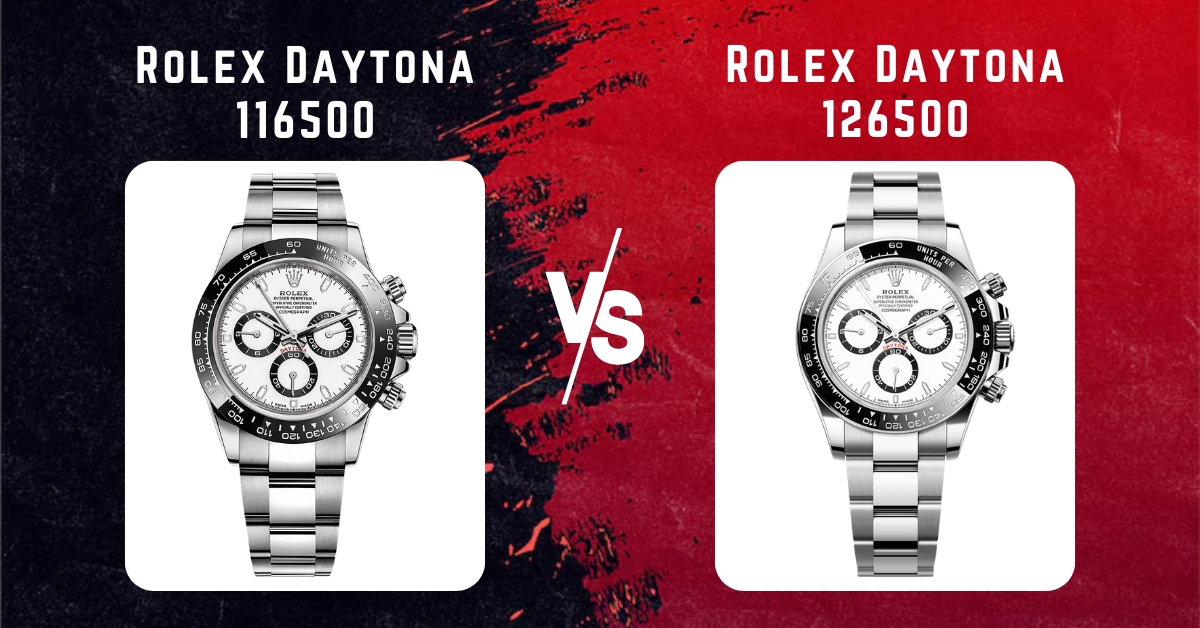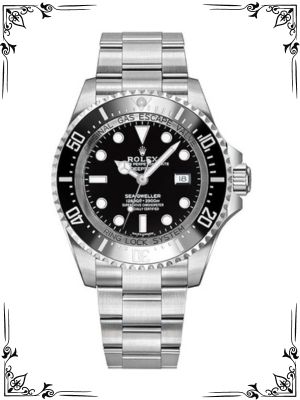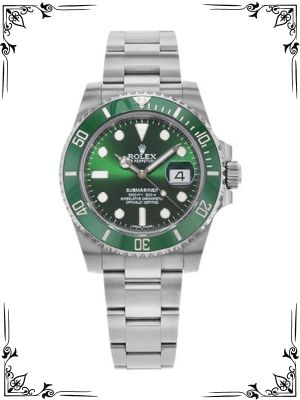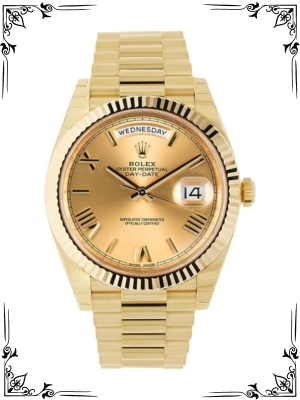The Rolex Daytona 116500 and 126500 boast the same chronograph functionality and iconic Oyster case. However, the 126500 introduces a sleeker profile with a slimmer case and bracelet, a redesigned dial with modernized subdials, and Rolex’s latest chronograph movement, the Calibre 4130.
Introduction
Congratulations! You’ve set your sights on a Rolex Daytona, a legendary timepiece coveted by watch aficionados worldwide. But with two prominent models – the 116500 and the newer 126500 – vying for your wrist, the decision can be daunting.
Fear not, this comprehensive guide will dissect the intricacies of both models, empowering you to choose the Daytona that perfectly complements your style and preferences.
History of the Rolex Daytona
The Rolex Daytona wasn’t always synonymous with luxury sports watches. In 1963, it debuted as the Ref. 6239, a tool watch designed for professional endurance racers competing on the grueling Daytona International Speedway.
Its chronograph functionality, robust construction, and tachymeter bezel – used to measure speed – made it a favorite among drivers like Mario Andretti and Sir Jackie Stewart.
Over the years, the Daytona transcended its utilitarian roots, evolving into a coveted luxury timepiece while retaining its motorsport heritage.
Technical Breakdown
Let’s delve into the technical specifications of the Rolex Daytona 116500 and 126500, highlighting the key differences that might influence your choice.
Movement
116500: Equipped with the Rolex Calibre 4130, a self-winding chronograph movement renowned for its precision and reliability. It boasts a 72-hour power reserve and is COSC-certified, a testament to its exceptional accuracy.
126500: Houses the upgraded Calibre 4130, featuring significant improvements. This next-generation movement offers a longer power reserve of approximately 70 hours and incorporates Rolex’s proprietary Chronergy escapement, designed to enhance efficiency and resistance to magnetism.
Table 1: Movement Comparison
| Feature | 116500 | 126500 |
|---|---|---|
| Movement | Calibre 4130 | Calibre 4130 (upgraded) |
| Power Reserve | 72 hours | ~70 hours |
| Escapement | Standard | Chronergy escapement |
Materials and Construction
Both models utilize Rolex’s legendary 904L stainless steel, a high-performance alloy renowned for its exceptional corrosion resistance and durability. The Oyster case construction ensures water resistance to a depth of 100 meters (330 feet), making them suitable for everyday wear and even light swimming.
Functions and Features
Chronograph: Both models boast a chronograph complication, a stopwatch function perfect for timing races or any activity requiring precise measurement of elapsed time. The chronograph features a central sweep seconds hand, a 30-minute counter at 3 o’clock, and a 12-hour counter at 6 o’clock.
Tachymeter Bezel: The iconic tachymeter bezel allows for calculating speed based on travel time over a fixed distance. A crucial tool for motorsport enthusiasts, it also adds a distinctive aesthetic element.
Screw-Down Crown and Pushers: These ensure optimal water resistance by securely locking in place.
Water Resistance
The 116500 and 126500 offer a water resistance rating of 100 meters (330 feet). This allows you to wear your Daytona for swimming or shallow diving, but avoiding activities involving high water pressure, such as scuba diving is best.
Design and Aesthetics
The visual appeal of a watch plays a significant role in the buying decision. Let’s explore the design elements that differentiate the 116500 and 126500.
Dial Design
116500: Features a classic tri-compax chronograph layout with snailed counters that offer a distinct textured appearance. The hour markers are applied luminescent Chromalight indexes.
126500: Introduces a modernized dial aesthetic. The subdials feature a sunray brushed finish that contrasts with the central dial area, offering a more dynamic look. Additionally, the hour markers are slightly wider and feature a more polished finish compared to the 116500. These subtle changes contribute to a more contemporary and refined aesthetic.
Table 2: Dial Design Comparison
| Feature | Rolex Daytona 116500 | Rolex Daytona 126500 |
|---|---|---|
| Subdial Finish | Snailed | Sunray Brushed |
| Hour Markers | Applied Chromalight Indexes | Wider, More Polished Applied Indexes |
| Chronograph Registers | Black or White | Black or White |
| Rolex Text | Raised Metallic | Raised Metallic |
| Daytona Text | Applied Metallic | Applied Metallic |
Case and Bracelet
Case: Both models utilize the Oyster case, a Rolex hallmark known for its robustness and water resistance. However, the 126500 boasts a slightly thinner profile with more sculpted lugs and a slimmer crown guard compared to the 116500. This updated case design offers a more modern and streamlined appearance.
Bracelet: Both models come equipped with the iconic Oyster bracelet, renowned for its comfort and durability. The 126500’s bracelet incorporates slightly tapered outer links that seamlessly integrate with the thinner case, contributing to its sleeker overall look.
Brand Image
Owning a Rolex Daytona signifies not just a timepiece but a status symbol. Both models carry the prestige associated with the Rolex brand, but the newer 126500 might hold a slight edge for some collectors due to its cutting-edge technology and potentially higher future value (given its recent release).
User Feedback
Here’s a glimpse into what real-world users appreciate and critique about each model:
Rolex Daytona 116500:
Praised for:
- Classic and timeless design: The tri-compax layout and snailed subdials have a loyal following who appreciate the traditional Daytona aesthetic.
- Proven Calibre 4130 movement: This movement offers exceptional performance and reliability, with a long track record of success.
- Potential future collectability: As a discontinued model, the 116500 might become more valuable over time due to its limited production run.
Criticized for:
- Thicker case profile: Some users find the 116500’s case to be slightly bulkier on the wrist compared to the newer 126500.
- Dial design might appear slightly dated: The traditional subdial finish might be perceived as less modern compared to the 126500’s sunray brushed finish.
Rolex Daytona 126500:
Appreciated for:
- Sleeker and more modern design: The thinner case profile, slimmer crown guards, and updated dial aesthetics resonate with those who prefer a contemporary look.
- Latest Calibre 4130 movement: The upgraded movement offers a longer power reserve and enhanced resistance to magnetism.
- Potential future investment piece: Given its recent release and advanced technology, the 126500 might hold significant investment potential.
Common critiques:
- Higher retail price: The 126500 carries a slightly higher price tag compared to the 116500 (discontinued models can sometimes be found at pre-owned retailers).
- Less established design history: With a shorter time on the market, the 126500’s collectability remains to be seen compared to the classic 116500.
Common Problems
Both the 116500 and 126500 are Rolex timepieces, renowned for their exceptional quality and durability. However, any mechanical watch can encounter issues over time. Here are some potential problems to be aware of:
Normal wear and tear: Regular servicing is crucial for maintaining optimal performance. Rolex recommends servicing your Daytona approximately every 10 years.
Scratches and dings: While Rolex’s 904L stainless steel is highly scratch-resistant, everyday wear can leave marks on the case and bracelet.
Movement malfunctions: Although rare, mechanical movements can malfunction. A qualified watchmaker can diagnose and repair any issues.
The Final Lap
The decision between the Rolex Daytona 116500 and 126500 boils down to your personal preferences and priorities. Here’s a quick recap to guide your choice:
The Classic Aficionado: If you cherish the timeless design of the Rolex Daytona and appreciate the proven performance of the Calibre 4130 movement, the 116500 might be your perfect match. The potential for future collectability due to its discontinued status adds another layer of appeal.
The Modern Enthusiast: For those who crave a sleeker aesthetic and the latest technological advancements, the 126500 emerges as the frontrunner. The upgraded Calibre 4130 with a longer power reserve and enhanced magnetism resistance offers peace of mind.
The potential for future investment due to its cutting-edge features might also be a deciding factor.
Beyond the Specs: Consider These Factors:
Budget: The 126500 carries a slightly higher retail price compared to the 116500 (which can be found pre-owned at times).
Wrist size: Try on both models to assess which case size feels more comfortable on your wrist. The 126500’s thinner profile might be ideal for those with smaller wrists.
Investment potential: While not the primary reason to buy a Rolex, both models have the potential to hold their value or even appreciate over time. The 116500, as a discontinued model, might see a steeper rise in value due to limited availability. However, the 126500’s advanced technology and recent release could also make it a desirable collector’s item in the future.
Ultimately, the best Rolex Daytona for you is the one that resonates most with your taste, complements your lifestyle, and brings you joy every time you wear it. Don’t hesitate to visit authorized Rolex retailers to try on both models and experience the magic of these legendary timepieces firsthand.
Conclusion
The Rolex Daytona 116500 and 126500 represent the pinnacle of watchmaking excellence. This detailed comparison has equipped you with the knowledge to make an informed decision.
So, whether you’re drawn to the classic appeal of the 116500 or captivated by the modern advancements of the 126500, you can confidently choose the Daytona that will become a cherished companion for years to come.
FAQs
Is it difficult to get a Rolex Daytona?
Yes, Rolex Daytona models are highly sought-after, and wait times at authorized dealers can be long. However, building a relationship with a retailer and expressing serious interest can increase your chances of acquiring one. The pre-owned market also offers options, but be sure to purchase from a reputable seller.
How much does a Rolex Daytona cost?
The retail price for the Rolex Daytona 126500 starts at around $14,550 USD. The 116500, being a discontinued model, can vary in price depending on its condition and where you purchase it. Pre-owned models can be found for slightly less than the retail price of the 126500.
Which Rolex Daytona is a better investment?
Both models have the potential to be valuable investments. The 116500, due to its discontinued status, might see a steeper rise in value in the long run. However, the 126500’s cutting-edge technology and recent release could also make it a desirable collector’s item in the future. Ultimately, the future value of any watch depends on market conditions and overall demand.
Can I finance a Rolex Daytona?
Some authorized Rolex retailers might offer financing options. However, it’s important to carefully consider the interest rates and ensure the monthly payments fit your budget. Exploring pre-owned options can also be a more budget-friendly way to acquire a Daytona.
Where can I get my Rolex Daytona serviced?
Only authorized Rolex service centers are qualified to service your Daytona. They have the expertise and genuine parts to ensure your watch remains in top condition for years to come.




